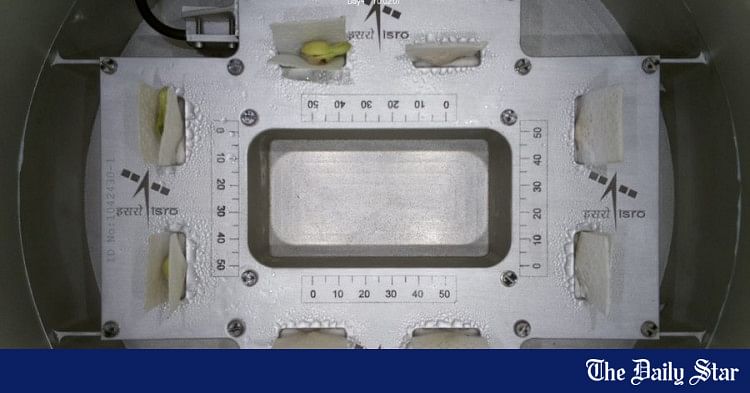Saif
Senior Member
- Jan 24, 2024
- 12,596
- 6,968
- Origin

- Residence

- Axis Group

Date of Event:
Dec 25, 2024
India’s push for home-grown satellite constellation gets 30 aspirants
REUTERS
Published :
Dec 24, 2024 21:39
Updated :
Dec 24, 2024 21:39

A satellite model is placed on a picture of Earth in this illustration taken November 25, 2024. Photo : REUTERS/Dado Ruvic/Illustration/Files
Thirty Indian companies have answered the space regulator’s call to build and operate constellations of Earth observation (EO) satellites in a groundbreaking private-public partnership to reduce the country’s reliance on foreign data for defense, infrastructure management and other critical mapping needs.
“We have received 9 applications ... Each applicant represents a consortium, involving a total of 30 companies,” said Pawan Goenka, chairman of the Indian National Space Promotion and Authorisation Centre, or IN-SPACe.
The regulator had sought “expressions of interest” (EoI) in July to build home-grown satellite constellations as part of a broader strategy to monetize the sector and ensure data sovereignty.
India is doubling down on its small satellite and data services market to carve out a leading role in the global commercialization of space. The market for such services, increasingly key for industries ranging from telecoms to climate monitoring, is projected to reach $45 billion by 2030, opens new tab.
The applicants for IN-SPACe’s latest effort in this regard include startups such as Google-backed Pixxel and Baring Private Equity-backed SatSure, as well as larger entities like Tata Group’s Tata Advanced Systems. The companies did not immediately respond to requests for comment.
Goenka said he expects technical evaluations to be completed by the end of January, after which a tender will be floated to determine the winning bidder.
IN-SPACe’s eligibility criteria include applicants raising or investing at least 850 million rupees ($10 million) in space-related activities, having a valuation of 8.5 billion rupees, or a turnover of 2 billion rupees in the past three years.
They must also set up spacecraft control centres in India or partner with ground station service providers for operational needs.
The government plans to loan up to 3.5 billion to the winner, with private companies expected to cover the remaining costs, according to a source familiar with the matter.
Since opening the sector to private players in February, India has established a 10-billion-rupee venture fund to support space startups.
The country has also unveiled ambitious plans for crewed space exploration and a mission to Venus, but the primary focus remains on fostering commercial ventures and scaling up private sector participation.
India currently sources much of its EO data from foreign companies and agencies like the European Space Agency (ESA) and the Indian Space Research Organisation (ISRO).
IIFCL Projects Ltd, an advisory arm under the Ministry of Finance, is overseeing the bidding process.
REUTERS
Published :
Dec 24, 2024 21:39
Updated :
Dec 24, 2024 21:39
A satellite model is placed on a picture of Earth in this illustration taken November 25, 2024. Photo : REUTERS/Dado Ruvic/Illustration/Files
Thirty Indian companies have answered the space regulator’s call to build and operate constellations of Earth observation (EO) satellites in a groundbreaking private-public partnership to reduce the country’s reliance on foreign data for defense, infrastructure management and other critical mapping needs.
“We have received 9 applications ... Each applicant represents a consortium, involving a total of 30 companies,” said Pawan Goenka, chairman of the Indian National Space Promotion and Authorisation Centre, or IN-SPACe.
The regulator had sought “expressions of interest” (EoI) in July to build home-grown satellite constellations as part of a broader strategy to monetize the sector and ensure data sovereignty.
India is doubling down on its small satellite and data services market to carve out a leading role in the global commercialization of space. The market for such services, increasingly key for industries ranging from telecoms to climate monitoring, is projected to reach $45 billion by 2030, opens new tab.
The applicants for IN-SPACe’s latest effort in this regard include startups such as Google-backed Pixxel and Baring Private Equity-backed SatSure, as well as larger entities like Tata Group’s Tata Advanced Systems. The companies did not immediately respond to requests for comment.
Goenka said he expects technical evaluations to be completed by the end of January, after which a tender will be floated to determine the winning bidder.
IN-SPACe’s eligibility criteria include applicants raising or investing at least 850 million rupees ($10 million) in space-related activities, having a valuation of 8.5 billion rupees, or a turnover of 2 billion rupees in the past three years.
They must also set up spacecraft control centres in India or partner with ground station service providers for operational needs.
The government plans to loan up to 3.5 billion to the winner, with private companies expected to cover the remaining costs, according to a source familiar with the matter.
Since opening the sector to private players in February, India has established a 10-billion-rupee venture fund to support space startups.
The country has also unveiled ambitious plans for crewed space exploration and a mission to Venus, but the primary focus remains on fostering commercial ventures and scaling up private sector participation.
India currently sources much of its EO data from foreign companies and agencies like the European Space Agency (ESA) and the Indian Space Research Organisation (ISRO).
IIFCL Projects Ltd, an advisory arm under the Ministry of Finance, is overseeing the bidding process.















